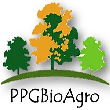Banca de QUALIFICAÇÃO: WILLIAN TSUYOSHI KUME
Uma banca de QUALIFICAÇÃO de MESTRADO foi cadastrada pelo programa.DISCENTE : WILLIAN TSUYOSHI KUME
DATA : 17/12/2020
HORA: 14:00
LOCAL: Vídeo conferência - meet.google.com/xar-tgwd-wnn
TÍTULO:
ZINC OXIDE NANOPARTICLE IN CORN CULTURE NUTRITIONPALAVRAS-CHAVES:
Foliar fertilization, seed treatment, nutrient solution, nanotechnology in plant nutrition.PÁGINAS: 76
GRANDE ÁREA: Ciências Agrárias
ÁREA: Agronomia
SUBÁREA: Ciência do Solo
ESPECIALIDADE: Fertilidade do Solo e Adubação
RESUMO:
Corn is the most cultivated cereal in the world and has great economic relevance, since it is used as a raw material for multiple sectors. Thus, proper crop management is essential especially when aiming higher yields and grains with better quality. In this context, Zn stands out since its deficiency is one of the most limiting factors for the development of culture. Given the above, the objective of this study was to evaluate the effect of seed treatment with doses of Zn in the form of sulfate and in the form of nanoparticles on the germination and seedling development, the effect of doses of Zn in nutrient solution and foliar fertilization with doses and sources of Zn in corn. The first experiment was in a 4x2 factorial scheme with doses (0, 20, 40, 80 g kg-1 of seed) and sources of Zn (ZnSO4 and ZnO 60 nm) and the second experiment with sources of Zn (ZnSO4, ZnO 60 nm and ZnO 40 nm). For both experiments, the DBC with four replications was applied and the seedling and root length, stem diameter, fresh and dry mass, root volume, IVG and germination rate were evaluated. The field experiment was carried out in the city of Alta Floresta - MT in a RED YELLOW OXISOL. DBC was used in a 4x2 factorial scheme with doses (0, 250, 500 and 1000 g ha-1) and sources (ZnSO4 and ZnO 40 nm) with four replications and foliar application in stage R1. At the end of the experiment, productivity, ear diameter, mass of 100 grains, number of rows per ear and Zn content in the grains were evaluated. The hydroponics experiment was carried out in a greenhouse and the DBC was used with doses of Zn (0, 1, 2, 4 and 8 mL L-1). At the end of the experiment, the shoot and root length, stem diameter, root volume, shoot dry mass, protein and micronutrient content were evaluated. The application of nanometric sources in the treatment of seeds promoted greater IVG, green and dry mass, length of the aerial and root parts in relation to the sulfate source. Comparing the nanometric sources, the 40 nm source promoted a higher green mass value of the aerial part, suggesting a greater absorption of the smaller size oxide source. In the field experiment there was no significant difference in the analyzed variables. This fact suggests that the Zn content present in the soil was sufficient to meet the nutritional needs of the corn hybrid used. Regarding the Zn content in the grain, more than one application of the micronutrient is recommended during the culture cycle. It was evident in the hydroponics experiment the lowest corn development when deficient in micronutrient. The group with dose 0 showed lower values for growth variables. In addition, nutritional imbalance was observed through the greater accumulation of Fe, Mn and B due to Zn deficiency. Also, it was found that the excess of micronutrient promoted lower values of shoot dry mass, stem diameter and root volume compared to the ideal dose (1 mL L-1) due to the phytotoxic effect.
MEMBROS DA BANCA:
Presidente - 210865003 - GUSTAVO CAIONE
Interno - 117000004 - MARCO ANTONIO CAMILLO DE CARVALHO
Externo ao Programa - 006.844.991-77 - GUILHERME FERREIRA FERBONINK - null



